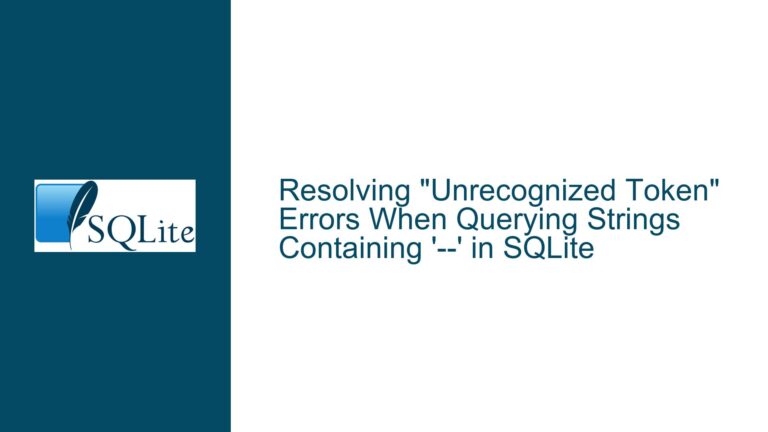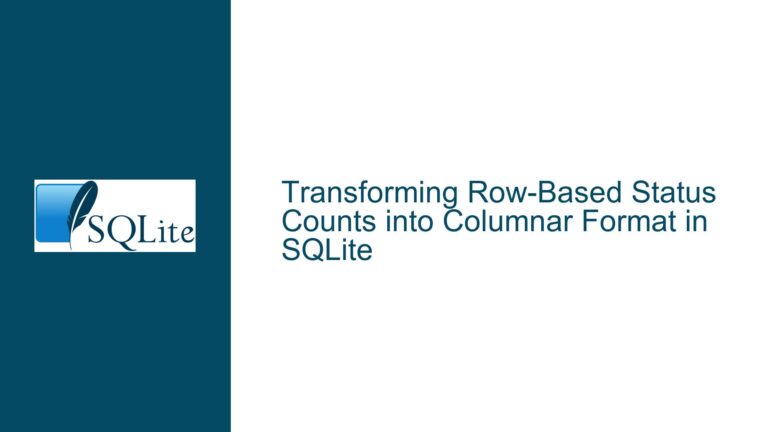Unexpected Row Updates Due to Subquery in WHERE Clause
Subquery Evaluation Interference During Single-Pass UPDATE Optimization
Issue Overview
The core problem revolves around an SQLite UPDATE query that unintentionally modifies rows due to interference between a subquery in the WHERE clause and a single-pass optimization mechanism. The scenario involves a table t1 with two rows: (3, NULL) and (6, -54). Three test cases highlight the anomaly:
- Test Case 1: An
UPDATEtargeting rows wherec5 IS NULLcorrectly modifies one row (3| → 100|). - Test Case 2: An
UPDATEusing a subquery-derived condition(NOT ((SELECT MIN(vkey) FROM t1) * (-10) >= t1.c5))updates zero rows. - Test Case 3: Combining the two conditions with
ORunexpectedly updates both rows (3| → 100|and6|-54 → 100|-54).
The anomaly occurs because the subquery (SELECT MIN(vkey) FROM t1) in Test Case 3’s WHERE clause evaluates to different values during the UPDATE process. Initially, MIN(vkey) is 3 (from the first row). After the first row is updated to vkey=100, the subsequent evaluation of MIN(vkey) becomes 6 (the second row’s original value), allowing the second row to satisfy the condition (6 * -10 >= -54) → -60 >= -54 → false, thus triggering the update. This violates the expectation that conditions in an OR clause should operate on the original dataset independently.
The root conflict lies in SQLite’s one-pass optimization for UPDATE and DELETE operations. This optimization attempts to modify rows in a single pass through the table, interleaving row selection and modification. When subqueries are present in the WHERE clause, their delayed evaluation (due to short-circuit operators like OR) may reference already-modified data, leading to incorrect results.
Mechanism of the One-Pass Optimization and Subquery Interference
How the One-Pass Optimization Works
In SQLite, UPDATE and DELETE operations traditionally follow a two-phase process:
- Identification Phase: Compute the set of rows to modify using the
WHEREclause. - Modification Phase: Apply changes to the identified rows.
The one-pass optimization merges these phases into a single loop. As the database engine scans each row, it immediately evaluates the WHERE clause and applies modifications if the condition is met. This reduces I/O overhead and improves performance but introduces risks when the WHERE clause contains subqueries that reference the same table being modified.
Subquery Evaluation Timing and Short-Circuit Operators
The OR operator in SQLite uses short-circuit evaluation: if the first condition (t1.c5 IS NULL) is true, the second condition is not evaluated. However, when the first condition is false, the second condition (NOT (...)) must be computed. In Test Case 3:
- For the first row (
3, NULL),t1.c5 IS NULListrue, so the row is updated tovkey=100immediately. - For the second row (
6, -54),t1.c5 IS NULLisfalse, forcing evaluation of the subquery(SELECT MIN(vkey) FROM t1). At this point, the first row’svkeyhas already been changed to100, soMIN(vkey)returns6(from the second row). The condition becomesNOT (6 * -10 >= -54) → NOT (-60 >= -54) → NOT (false) → true, causing the second row to be updated erroneously.
This behavior violates the atomicity expectation of UPDATE operations: all conditions should be evaluated against the original dataset.
Why the Subquery Isn’t Cached or Precomputed
SQLite does not automatically cache subqueries in WHERE clauses unless explicitly instructed (e.g., using WITH clauses or materialized CTEs). The subquery (SELECT MIN(vkey) FROM t1) is re-evaluated for each row where the first condition fails, and by the time the second row is processed, the first row’s vkey has already been altered.
Resolving the Update Anomaly: Disabling One-Pass Optimization
The Official Fix
The SQLite team addressed this by disabling the one-pass optimization when the WHERE clause contains subqueries. This forces the engine to:
- Identify all qualifying rows using the original data.
- Apply modifications in a separate pass.
This ensures subqueries reference the pre-modification state of the table, preserving logical consistency.
Workarounds for Older Versions
For environments where upgrading SQLite is not immediately feasible:
Materialize Subquery Results Preemptively:
Use aWITHclause to compute the subquery result before theUPDATE:WITH min_vkey AS (SELECT MIN(vkey) AS mv FROM t1) UPDATE t1 SET vkey = 100 WHERE t1.c5 IS NULL OR (NOT ((SELECT mv FROM min_vkey) * (-10) >= t1.c5));This captures
MIN(vkey)at the start of the query, decoupling it from subsequent modifications.Split the UPDATE into Multiple Statements:
Separate conditions into distinctUPDATEoperations to avoid interference:UPDATE t1 SET vkey = 100 WHERE t1.c5 IS NULL; UPDATE t1 SET vkey = 100 WHERE NOT ((SELECT MIN(vkey) FROM t1) * (-10) >= t1.c5);Note: This might not work if the second
UPDATEdepends on the first’s changes.Use Transactions to Isolate Reads:
Force the entireUPDATEto read from a snapshot of the data:BEGIN TRANSACTION; -- Prevent writes to t1 by other transactions UPDATE t1 SET vkey = 100 WHERE (t1.c5 IS NULL) OR (NOT ((SELECT MIN(vkey) FROM t1) * (-10) >= t1.c5)); COMMIT;
Best Practices to Avoid Similar Issues
- Avoid Subqueries on the Updated Table: Refactor queries to use joins or precomputed values.
- Use Explicit Transactions: Isolate read and write phases to maintain consistency.
- Test with One-Pass Optimization Disabled: Temporarily disable the optimization using SQLite’s
PRAGMAsettings (e.g.,PRAGMA optimize_control = 'one-pass-disable';) to identify optimization-related bugs.
This guide systematically addresses the interplay between SQLite’s optimization strategies and subquery evaluation, providing both immediate fixes and long-term preventative measures.






